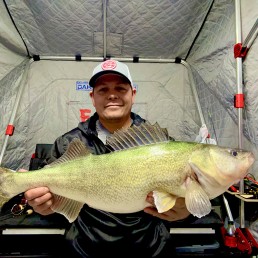Ice Camping: Extending the Experience
SHARE THIS POST
Ice camping, for lack of a better term, is a great way to extend the ice fishing experience—offering anglers an affordable way to stay on the ice and increase their fishing time. It’s a good alternative to more traditional lodging options. Not to mention, the use of portable accommodations also offers the ability to get to areas that larger hard houses cannot.
Mike Klatt, a seasoned ice veteran, is no stranger to ice camping and is more well-versed in the activity than most. As the man behind YouTube’s Reel Life with Mike, he’s filmed countless videos on the subject. “I just love ice camping,” says Mike. “It’s such a unique experience. The sights, sounds and atmosphere are really second to none.” As an experienced ice camper, Mike knows just how important the right gear and preparation are to a successful ice camping experience.
Perhaps the most important piece of gear for an enjoyable endeavor is an ice shack. Thankfully, there are a variety of premium level options on the market. Key considerations for choosing the right shelter include budget, size, weight, ease of setup, and warmth retention. While you can camp in a flip-over, hub or pop-up, shacks are better suited for the activity. “My favorite shack for ice camping is the Eskimo Outbreak 650XD,” adds Klatt. “I’ve tested several different shelters, but the 650 just seems to be perfect. It’s a well-built shack that offers plenty of space for two cots, four holes and all the necessary gear.”
In addition to the shelter, heating is an important factor for ice camping. The most common sources are propane based, simply due to their reliability and availability. Diesel heaters are also growing in popularity, but often require a little DIY work to be set up properly. Klatt reminds campers about the importance of a high-quality heat source. He continues, “You need to have the right heating source for your setup. It’s also important to make sure you have adequate fuel for the duration of your trip.” One of the biggest concerns with heating sources is carbon monoxide. As a result, a carbon monoxide detector (or two) is a vital item for staying on the ice. It can literally make the difference between you getting home or not.
If you want to be comfortable while ice camping, some additional gear is necessary. Floor insulation is a must-have—offering you and your gear a layer of protection from the ice. For the best results, invest in quality rubber or foam flooring. When it comes to sleeping, a cot, sleeping pad and sleeping bag are all necessities. It’s fair to assume that you probably won’t get all that much sleep, especially if the fish are biting, but you still want to be comfortable. Mike weighs in on the importance of sleeping related gear: “A sleeping pad is the most important thing to me. Even if you have a subpar cot, a good sleeping pad can make a huge difference.”
Unlike campers and permanent houses, lighting isn’t something that’s built in. There’s a plethora of options on the market, ranging from portable to permanent sources. Perhaps the most beneficial source is a headlamp, as it helps with setup, takedown, and anytime you don’t need some extra light. Other options include traditional lighting, like propane lanterns, or more conventional lighting, like battery-powered lights. Newer light sources are extremely efficient and can often run for days on a single battery.
Are you enjoying this post?
You can be among the first to get the latest info on where to go, what to use and how to use it!
Similar to traditional camping, food is an important factor when camping on the ice. Meal options are largely dependent on the cooking options you drag along. One could obviously take the easy route and pack pre-made items or, if wanted, prepare something a little more extravagant. The most universal cooking options are camp stoves as they offer the ability to cook in a variety of ways. It can be difficult to plan for three square meals for every day on the ice, but common selections include brats, steaks, eggs, sandwiches, soups, and the ever-favorite deep-fried fish. Ensure that you have the proper utensils for your cooking methods.
Bathroom facilities are pretty important to an enjoyable trip. A portable toilet, like a bucket with a seat, is a great option for containing the mess. Remember to bring adequate garbage bags. In some instances, folks set up a separate, smaller shack to be used strictly as a bathroom.
Days can get long on the ice, especially if the fish aren’t biting. It’s always nice to have some options for entertainment. Games, cards, or even a tablet with some downloaded content can certainly help the less-thrilling hours pass by.
According to Klatt, his best piece of advice for an ice camper is to make a list. “It’s easy to forget things, especially when you need so much. Almost every time I’m out, it seems like we forget something.” He also highlights the importance of experimentation with layouts. “The setup that works for you, may not work for someone else, and vice-versa. I tried at least ten different layouts before settling on the one I like best.” Remember to enjoy the experience and leave no trace behind.
For more insight and tips on how to make the most of the time you spend fishing, check out the articles in every issue of MidWest Outdoors, available by subscribing on our website.
MWO
SHARE THIS POST
You may also like...
Nothing found.
Did you enjoy this post?
You can be among the first to get the latest info on where to go, what to use and how to use it!
